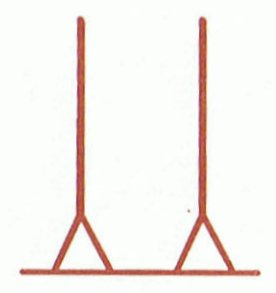The Roman letter V signifies 'five' (as if it illustrated an open hand seen from the side). By cause of the 4 'pillars' holding the sky up it is also possible to read V as 'fire' (which we hardly would have done without knowing that Polynesian rima means both 'fire' and 'hand'):
Roman X means 10, which we can see is twice V, the lower of them upside down. 10 is the full cycle of the decimal system. The 4 pillars of Khnum presumably means we should count 4 * 5 = 20. In a year with 360 days we must use 18 sets of these pillars for the full cycle. If we count each pillar as 50 (zero being nothing to illustrate), then 4 * 5 = 200. On the other hand we should use also menchet:
In addition to 20 (for the time of light) we have 2 * 5 = 10 for the time of 'cloth'. 20 + 10 = 30 measures the length of a month, and 12 * 30 = 360. Or we can count 2 * 50 = 100, which 'supports' a Sun year with 200 + 100 = 300 days. If we now move to Easter Island we have to invert the signs:
20 can now be understood as 20 nights of the Moon (though we can still read Sun in the form of the pillars, of course, and ought to change them from the Egyptian to the Easter Island system). This presumably explains why the Gilbertese did not count the nights of the month beyond number 20 (cfr at ua). |


